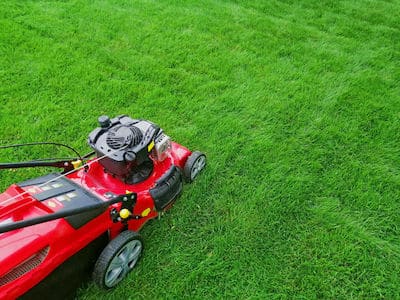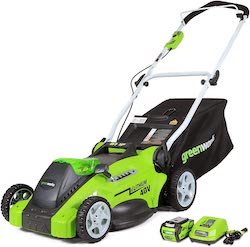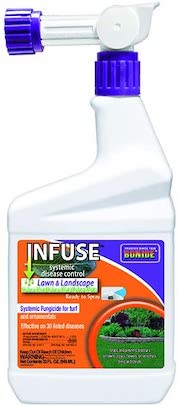A luscious green lawn can be the envy of the neighborhood. However, despite your best attempts, sometimes grass can have a mind of its own. With countless diseases that can damage your lawn, it’s easy to become discouraged at the sight of a new problem area. One common lawn problem that frustrates homeowners across the country is grass that develops white tips.
What does my grass have white tips? There are a few things that could cause your grass to have white tips. Luckily it’s fairly easy to differentiate between potential problems. Most often, a white-tipped lawn is caused by a lawn disease called Powdery Mildew. Other causes for white-tipped grass include damage from dull mower blades or damage from drought or dry season.
In this post, we will take a more in-depth look at the various causes of white-tipped grass. We will also discuss how to determine what is causing your yard woes and how to easily solve the problem. With the help of our expert lawn care tips, you too can have the greenest grass on the street.
If your grass is turning yellow read our article on why your lawn has yellow tips.
If your grass has red tips read our article on why your lawn has red tips.
What to Do About Grass With White Tips
There are not many things more frustrating than dedicating your weekends to perfecting your lawn care routine only to realize that your grass is suffering from some type of disease or damage. Keep reading to learn how to easily diagnose the underlying cause of the white tips on your grass as well as how to quickly remedy the situation.
Understanding Why Your Grass Has White Tips
If you have recently noticed that your grass has white tips, it is likely due to three common culprits. The most common causes of white-tipped grass are a lawn disease known as Powdery Mildew, damage caused by your lawnmower, or drought. Fortunately, these conditions are relatively easy to differentiate with a closer look at the blades of grass that are affected.
1. Lawn Disease
 Powdery Mildew is can cause white patches of grass throughout your yard. Typically, these patches are found in shaded areas or areas that often have standing water. Powdery mildew is a pretty common lawn disease, especially for varieties like Kentucky Bluegrass.
Powdery Mildew is can cause white patches of grass throughout your yard. Typically, these patches are found in shaded areas or areas that often have standing water. Powdery mildew is a pretty common lawn disease, especially for varieties like Kentucky Bluegrass.
A closer look at your grass will reveal that the white tips are actually caused by a dust-like substance. This will closely resemble talcum powder and cover the entire blade of grass. While powdery mildew isn’t overly invasive, it will easily spread to other areas of your yard if you mow over the affected patches. You can find our tips for recognizing and treating lawn fungus here.
2. Damage Caused By Lawn Mower
Another common cause for white-tipped grass blades is damage caused by your lawnmower. When you cut your grass too short, it is not able to receive the nutrients it needs to thrive. This can cause the grass to become pale in color.
Lawnmower damage can also be caused by mowing your lawn with a dull blade. When you are mowing your lawn with a dull blade, the tops of your grass may appear frayed and lose their color. In some situations, this may give off a white color.
If your white-tipped grass is caused by lawnmower damage, it will likely be a wide-spread condition that covers your yard instead of sporadic patches. It may be time for a new lawn mower or at least a new blade.
3. Drought
The third and final reason your grass may have white tips is a drought or excessive dryness. When your grass is damaged due to drought, you will notice widespread damage along with possible frayed blades.
If you live in a region that experiences seasonal drought, or if your area hasn’t gotten sufficient rainfall, it is safe to assume that lack of water is the culprit. This could also happen if your lawn does not have proper irrigation, prohibiting water from reaching the roots.
Remedies for Grass With White Tips
Fortunately, there are several things you can do to fix your grass if you have noticed white tips in your yard. It may take some time and effort to remedy the situation. However, working on your lawn not only improves the curb appeal of your home but also creates a more enjoyable living space.
1. Review Your Lawn Maintenance Schedule
If powdery mildew or disease is the cause of your white-tipped grass, it is a good idea to review your lawn maintenance schedule. Take a walk around your yard to identify areas that have been affected by the disease. Eliminate shade when possible and check that your grass can drain properly.
It is important to ensure that you are providing your lawn with enough water and fertilizer. However, both too much fertilizer and too much water can lead to further damage or a spread of powdery mildew.
If the powdery mildew does not disappear after implementing a new lawn maintenance schedule and improving the sunlight to the area, you may need to consider a spray-on fungicide. This type of solution can be found at your local hardware store or a greenhouse.
2. Adjust Your Lawn Mower Blade Height
Widespread white tips across your lawn are an indication of a problem other than powdery mildew. Each time you mow your lawn, it is important that you are cutting no more than ⅓ of the blade length each time. If the blades appear damaged, raise the height of your lawnmower to allow your lawn to repair itself.
3. Sharper Your Lawn Mower Blades
On average, lawnmower blades should be sharpened every 20 to 25 hours of use. Depending on the size of your yard and how often you mow, this may be more or less than once per season. Most local hardware stores offer blade sharpening services or you can find directions for how to sharpen your lawnmower blades online.
![]() Sharpened lawnmower blades will provide a precise cut that minimizes that damage to the blades of grass. This will help to reduce the appearance of damage that is widespread throughout your yard.
Sharpened lawnmower blades will provide a precise cut that minimizes that damage to the blades of grass. This will help to reduce the appearance of damage that is widespread throughout your yard.
4. Irrigate Your Lawn to Nourish Roots
If your lawn appears to be dry and damaged, it may look like it has white tips. After ruling out the possibility of drought or underwatering, consider irrigation. Irrigating your lawn will help ensure that water can reach the roots and provide the necessary nutrients.
5. Helping Your Lawn Recover From Drought
In many areas of the country, there are seasons during the summer that many consider to be a drought. If your area has experienced drought, you may need to take some special steps to help your grass recover from drought.
What to Do If Your Grass is Ruined By White Tips
While it is not common, there may be some situations where your grass is not able to recover from the condition that caused white tips. After implementing some of the steps listed above with no results, you may want to consider reseeding your yard. This may be quite an investment of time and resources. However, it can be the best way to achieve the lawn of your dreams.
![]()
If you decide to replace your lawn it is important to research the best type of grass for your area. Choosing the right type of grass will not only make lawn maintenance much more simple but will also be the best investment in the longterm. It is always a good idea to ask a lawn care professional for advice before investing in such a large project. Whether a lawn care company, your local hardware store, or a landscaping contractor, they can help guide your decision down the right path.
 White tips popping up around your lawn may be a cause of frustration and concern. We hope that these lawn care tips help you eradicate the problem once and for all.
White tips popping up around your lawn may be a cause of frustration and concern. We hope that these lawn care tips help you eradicate the problem once and for all.
Thank you for reading American Lawns!






